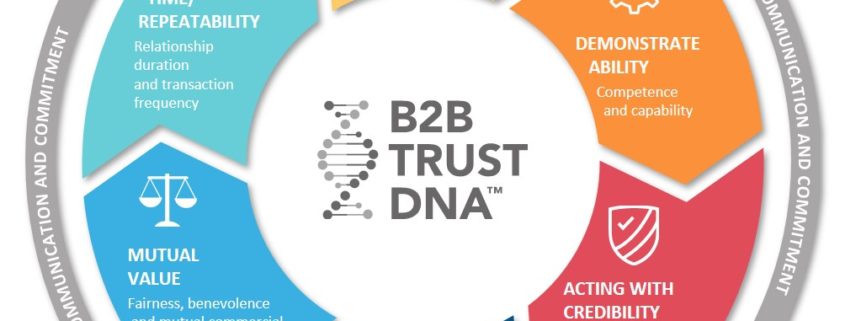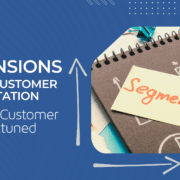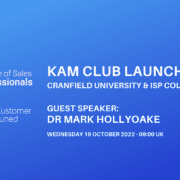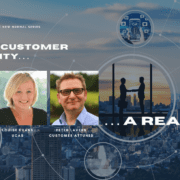Unpacking the B2B Trust DNA™ Model
Trust is a key dynamic in business to business (B2B) relationship success. It is often quoted and referenced, yet little understood.
It has taken me over five years of academic doctoral research to establish just how trust works on a multi-level context that covers both sides of the relationship. This research proves that B2B trust is dynamic and – more importantly – how it can be pro-actively applied to business relationship development.
Firstly, let’s look at how it has been redefined as a result of the insights generated from my research:
“The willingness to be vulnerable to another party and the decision to engage in
actions based upon an interpretation of their ability, credibility and the
expectations of mutual value exchange over time.”
Hollyoake, M. (2020)
This provides the components of a straightforward ‘equation’:

B2B Trust can thus be nurtured through the proactive and systemic application of this equation and its associated Trust DNA™ model, which this article sets out to briefly unpack.
Therefore, if as a company you clearly set out your intentions, and then demonstrate your abilities and credibility in an interdependent way in all your dealings over time, you will generate mutually valuable, trusted customer relationships.
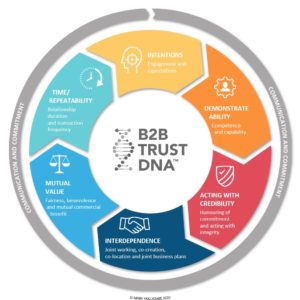 The Trust DNA™ model (illustrated) sits at the heart of this B2B trust development approach. I will explain how each component of the model works, and how each section is interlinked, as practically and pragmatically as possible.
The Trust DNA™ model (illustrated) sits at the heart of this B2B trust development approach. I will explain how each component of the model works, and how each section is interlinked, as practically and pragmatically as possible.
My 348 page / 103,500 word thesis is available if you would like to see all the detail!
How does it work?
The model covers both sides of the relationship, and starts with relational intent.
Intentions: At this stage, both sides need to be clear about what they expect from the relationship – the mutual benefit opportunity and what’s involved in order to achieve it.
This isn’t a one-way process as it needs both sides engaged to set the intentions.
At this stage, the role of the account manager and procurement manager are key in providing the reassurance that the business relationship will deliver the expected intention, helping both sides turn a ‘leap of faith’ into a small step. From experience and research, it is at this stage, that you may face either side trying to mitigate their ‘feeling of vulnerability’ by introducing clauses and conditions into the contract. This can be overcome or limited by jointly demonstrating the opportunity to mitigate the risk and reduce the need for needless clauses and conditions.
If you are going to invest your time, energy and money, how certain are you it will deliver what you expect? Do you trust the other side to come through with the deal and a mutual value outcome or will it need to be wrapped up in contracts or service level agreements (SLAs)?
The relationship when activated and/or transacted moves from intention and into reality or active trust building. This brings into play ability, credibility, and the way you work together.
Demonstrate Ability: It is at this point both sides start to demonstrate their capability and competency to turn their intentions into a reality. It’s the rubber hitting the road moment. In a mature relationship this manifests in the ability for both sides to adapt, change and recalibrate the relationship to keep delivering on the intention and expected mutual value.
Are you are seen as a leading supplier in your category or sector? Does the leveraging of your insights and ability justify that position? Do your customers have the ability to take on board your insights and recommendations, turning them into mutual commercial benefit? Have they got ‘experts’ in the organisation who know what you’re talking about and see the opportunities making them happen within the organisation, so you see it come to life in your joint performance?
Acting with Credibility: In conjunction with ability comes credibility, with clear demonstration of both sides doing what they said they would. Both organisations act with integrity, role modelled by the leadership teams. Values and ethics focus on doing the right though for the relationship in pursuit of the intentions and mutual value delivery.
When operating in the category and sector, you both know how it works. Your customer has a track record of performance and delivery. A good level of shared values and beliefs exists between both sides, and if you both agree to do something it gets done.
Interdependence: Both sides in the relationship work together well across the various functions and at different levels. You enjoy good levels of joint working and co-create solutions that add real value to the relationship. In some instances, you may swap staff as part of co-location. The more joint working undertaken in a relationship at all levels and functions the more it improves relational ability and credibility, it increases relational dependence and potential to create mutual value. This is often cemented or embodied in a joint business plan. It also makes it more difficult, costly and potentially higher risk for competitors to enter the relationship at the same level.
How integrated are both sides at all levels in the delivery of the mutual relational benefits identified at the intention stage? What level of dependence exists between both sides and what is its effectiveness in delivering the expected and intended mutual benefits?
If the relationship is demonstrating ability, acting with credibility and working interdependently to deliver the intentions, it is highly likely the next area in trust building is coming through as expected – mutual value.
Mutual Value: The commercial value the relationship delivers is fair and equitable to both sides. Indeed, both sides want to assure the commercial viability of the other for business sustainability and continuity. This doesn’t mean it needs to be equal 50/50, however! It does need each side to feel comfortable with their share of the value. If it is then you are likely to continue and through that develop greater ability, credibility, and work together to create more value. If it’s not fair or mutually beneficial, then over time trust will erode in the relationship.
When you look at customer profitability, is the value figure representative of the amount you put in to achieve it? Is the relationship commercially balanced when you look at the value the relationship delivers? Who is taking what and does this represent ‘fair share’ that’s good for both sides?
The last element of the Trust DNA™ cycle is repeatability and time.
Time/Repeatability: As I have eluded to above, if the relationship is delivering on its intentions and created the expected mutual value, it is likely it will be repeated. Over time a relationship can develop (if both sides have the ability, credibility and interdependence to do so) into one that’s formed on ‘identification based’ trust and often referred to as a strategic relationship, trusted partner, trusted adviser, etc.
Another indicator of trust in a relationship in relation to repeatability is the frequency of the transactions, contract renewal, amount of the business for your sector you receive.
The Trust DNA™ model thereby operates like a B2B relationship engine, developing trust in the relationship and through that trust developing mutual value.
The engine has two lubrication systems that help it to run: Communication and Commitment. In this last section I will explore both of these in relation to trust building and the enablement of the Trust DNA™ model.
Communication: The agreed intentions for the business relationship must flow from the leadership teams down through the respective organisations to brief and enable the functions and people to make it a reality and deliver the desired outcomes and effects. This includes how the relationship communicates with each other both formally and informally, the style and type of the communication undertaken. It is important that communication isn’t seen as an e-mail issued from the senior leadership and then nothing after that!
Commitment: Does the leadership team demonstrate commitment to the relational intent beyond lip service, is it consistent and joined up? Are all the leadership team similarly committed, formally and informally? This manifests in leaders being the relational role models in their own organisations at all levels and also when interfacing with the other side of the relationship. Commitment to the relational intent and delivery of the expectation, also needs to be consistent at all levels of the relationship, i.e. interpersonal to interpersonal, operations to operations, and organisation to organisation – and then also between the levels! Commitment is an outcome of a trust-based relationship and not to be confused with an intrinsic measure of the level of relational trust.
I have attempted to unpack the Trust DNA™ model, the meaning of each section and how they relate to each other. This is obviously a lot more involved and complex than explored in this paper however, does provide a start point for further discussion for those that understand the power of B2B trust within relationships.
![]() If you would like to discuss how this can be applied to your own organisation and relationships, then please contact us.
If you would like to discuss how this can be applied to your own organisation and relationships, then please contact us.
- Stop hiding behind your computer and get out to see your customers! - March 6, 2024
- B2B Trust Research: What are Boundary Spanners? - January 31, 2024
- A Business to Business Model of Trust - June 27, 2023
